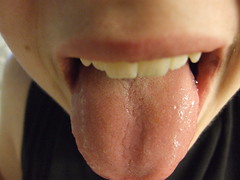Using the five senses is an important way to draw readers into your work and help them experience the character’s reality—but writing those senses can be a challenge. So this week we’re going to look at including the five senses in our writing.
I’m starting with sight because I think it’s the most obvious sense we include in writing. Whenever we describe setting or a character, we’re using sight. Our characters’ expressions, body language and movements can be part of sight (though not always).
 The challenges of sight
The challenges of sight
Just because sight is obvious doesn’t mean it’s always easy. As with all description (and all senses), the trick is to slip in that description without slowing the story.
For characters and settings, focus on active and revealing details. “She had dark blonde hair, green eyes, regular features and lots of freckles,” is such a generic description that it almost asks us to forget it immediately. But if we describe her with active verbs (when possible—going overboard is distracting), and focus on characteristics that make her unique, our descriptions—and our characters—will be more memorable and vivid. It may take more words, and you may only convey one or two features, but readers will have a better sense of the character.
Seeing the scene
Focusing on those active and revealing details—or inventing them—can be the hardest part of conveying the sense of sight. Here are some things I’ve done to try to use sight to its fullest in my scenes:
- Decide what kind of “mood” you want in this setting or scene. The same setting can be home to several scenes of different moods, or it can have a pervasive mood that dominates all its scenes.
- Consider the characters. What would the POV character notice because of his/her occupation, personality and interests? If it’s another character’s home or other personal space, what kind of furnishings would they use? What are the characters’ emotional states during this scene? Is this the character’s first encounter with this setting or person, or are they so familiar they hardly notice appearances anymore? (Also think of the character’s height—a short, timid character will see a tall fireplace differently than a tall or bold one.)
- Brainstorm details that would fit that mood or person. Think of more than you think you’ll need. Feel free to close your eyes and place yourself in that place—or better yet, in your character’s shoes.
- Choose the strongest images and those that best convey the mood or one or more characters. I think three is a good number to shoot for, but depending on the length of the scene and how much you want to
- Weave them in throughout the scene. Don’t plop them all in the first paragraph of the scene in static description: “She walked in the room. The fireplace stood tall by the imported damask drapes. The Persian rug was a little faded. The wingback chairs were mauve.” Skip, skip, skip.
- Use not just adjectives and adverbs, but nouns and verbs to convey the POV character’s perception and emotional state, as well as the mood of the scene (again). “The imposing fireplace stood tall . . .” tells us about the room; “The fireplace loomed over me,” lets us experience the character’s reality.
Seeing 20/20
And of course, since sight covers body language and movement, it’s important that those kinds of actions are clear. Time, distance and impartial eyes are usually the best ways to help these things.
What do you think? How do you focus on including sight in your scenes?
Photo by Nicki Dugan







